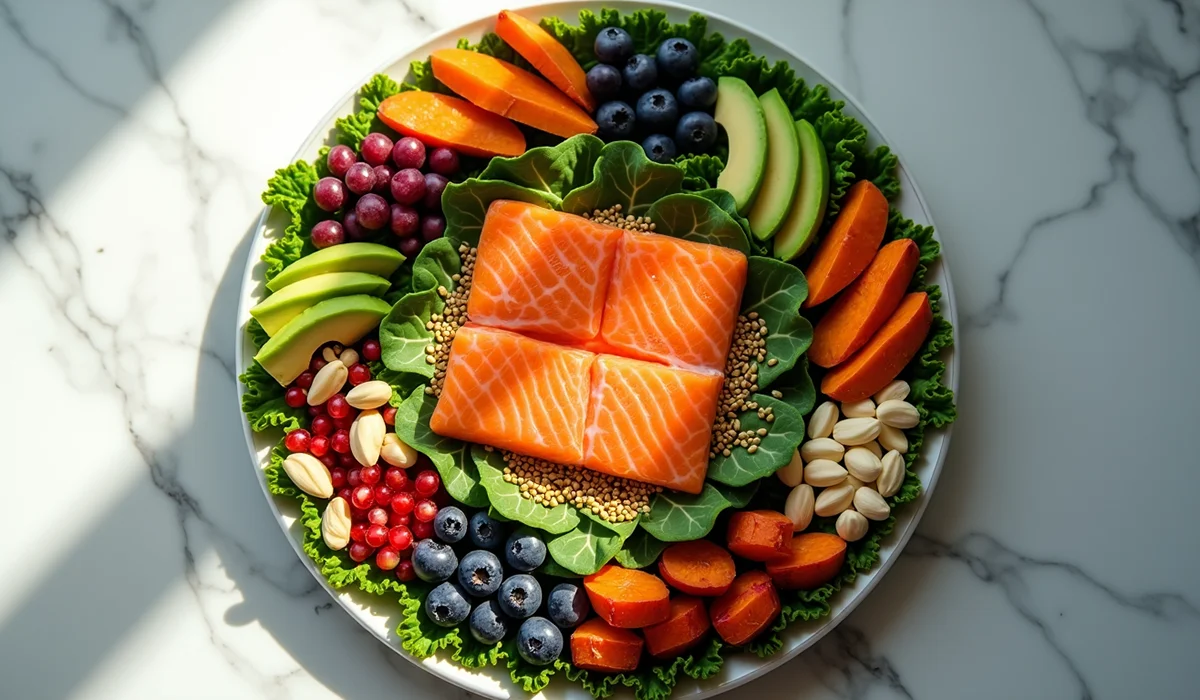Hormones control your appetite, food cravings, and even how your body stores fat. Millions of women suffer from hormonal imbalances that cause fatigue, painful periods, acne, bloating, and mysterious weight gain. Understanding the symptoms of hormone imbalance and learning how to balance hormones is crucial for overall health and well-being.
The numbers tell a startling story. Women with hormonal conditions like PCOS face a serious risk – more than half develop type 2 diabetes before turning 40. These problems are systemic, but science offers hope. Research proves that certain foods can naturally balance our hormones and support our mental, physical, and emotional well-being.
Your body needs the right mix of hormone-balancing foods. These foods pack vital nutrients like vitamin D, magnesium, and B vitamins that make a real difference. Your hormonal health depends on eating the right foods, especially when you’re dealing with insulin resistance, thyroid problems, or chronic fatigue.
This science-backed piece will show you the best foods to balance female hormones naturally. You’ll learn how to use nutrition to restore your body’s hormonal balance and feel energized again.
Understanding Female Hormone Systems
The hypothalamus arranges interactions between glands in our endocrine system to regulate reproduction [1]. This intricate system maintains our hormonal balance in fascinating ways. Understanding what hormone imbalance is and how hormonal changes affect our bodies is essential for maintaining optimal health.
Key Hormones and Their Functions
Three main hormones work together to maintain a woman’s reproductive health. Our ovaries produce estrogen and progesterone. Both ovaries and adrenal glands create small amounts of testosterone [1]. These hormones control:
- Metabolism and energy balance
- Reproductive cycles and fertility
- Growth and development
- Sleep patterns and mood regulation
- Sexual function and development [2]
Signs of Hormonal Imbalance
Disrupted hormonal balance can trigger several symptoms. Research shows that women with hormonal imbalances often notice irregular menstrual cycles, unexplained weight gain, and sleep problems [3]. Some women develop acne, hair loss, or excessive body hair growth, especially when their testosterone levels become unbalanced [4]. Recognizing these hormonal imbalance symptoms in females is crucial for early intervention and treatment.
How Food Affects Hormone Production
Nutrition is a vital part of maintaining hormonal health. Food serves as a building block for molecules that help produce and regulate hormones [5]. Poor nutrition can disrupt normal hormonal development and affect the hypothalamic-pituitary-gonadal axis [5]. Understanding how to regulate hormones through diet is key to maintaining balance.
Our diet’s quality and composition affect hormone production and metabolism by a lot. Studies show that diets rich in fish, vegetables, fruits, and whole grains help maintain optimal hormone function [5]. Foods high in saturated fats and processed ingredients can throw hormones out of balance, particularly affecting insulin and cortisol levels [6]. Natural remedies for hormone imbalance often start with dietary changes.
Essential Foods for Hormone Balance
Let’s look at natural foods that can restore our hormonal balance. Studies show specific nutrients support our endocrine system and keep our hormone levels optimal. Learning how to balance hormones naturally through diet is a powerful tool for women’s health.
Hormone-Supporting Proteins and Fats
Our bodies need protein and healthy fats because they create hormones. Research shows eating 25-30 grams of protein at each meal reduces hunger hormones and makes you feel full [7]. Cold-water fish contain omega-3 fatty acids that boost insulin sensitivity and help produce hormones [8]. You should add these healthy fats to your diet:
- Fatty fish (salmon, mackerel, sardines)
- Avocados
- Raw nuts and seeds
- Grass-fed meats
- Organic eggs
Significant Vitamins and Minerals
Our hormone health needs specific nutrients. Selenium stands out as a key mineral that supports thyroid function and fertility [9]. Vitamin D regulates estrogen and progesterone production to keep them balanced [10]. B12 helps your thyroid work properly and creates adrenal hormones [10]. These nutrients play a crucial role in maintaining hormone balance for women.
Anti-inflammatory Foods
Hormone balance suffers when inflammation becomes chronic. Scientists have found that foods rich in antioxidants fight both immediate and long-term inflammation [11]. These anti-inflammatory foods work best:
- Cruciferous vegetables
- Berries (especially blueberries and strawberries)
- Green tea
- Turmeric and ginger
- Leafy greens
Research reveals these foods contain glucosinolates – compounds that act as antioxidants and help regulate hormone production [12]. Fiber-rich foods like beans and quinoa improve gut health and help remove excess estrogen from your body [12]. Incorporating these foods into your diet can be an effective way to fix hormonal imbalance naturally.
Strategic Meal Planning for Hormone Health
Meal timing and food combinations play a vital role in our hormone balance. Understanding these principles helps create a better hormone-balancing diet plan and supports overall endocrine system health.
Optimal Meal Timing
Your body’s circadian rhythms and hormonal regulation work best when you eat at consistent times [13]. The best practice involves eating within an hour of waking up to keep blood sugar levels steady throughout the day [14]. Your metabolism naturally slows down during the first half of the menstrual cycle, which means you need fewer calories. The luteal phase demands about 279 more calories daily [14].
Food Combinations for Maximum Benefits
Some food combinations work together to improve nutrient absorption and hormone balance [15]. These powerful pairs support your hormonal health:
- Spinach with citrus fruits (improves iron absorption)
- Salmon with broccoli and wild rice (improves bone health)
- Turmeric with black pepper (increases anti-inflammatory benefits)
- Beans with brown rice (creates complete protein source)
Portion Control Guidelines
Portion control is vital to maintain hormone balance. Your plate should look like this for the best results [16]:
- 1/4 plate: high-quality complex carbs (quinoa, brown rice, sweet potatoes)
- 1/4 plate: lean protein sources
- 1/2 plate: vegetables and fruits
Your hormone health needs food every three hours [14]. This helps keep blood sugar levels stable and prevents cortisol spikes that can throw off your hormonal balance [16]. Each meal should include protein (25-30 grams) to regulate your appetite hormones better [7]. This strategic approach to meal planning can be an effective way to fix hormonal imbalance and support overall endocrine health.
Foods to Avoid for Hormone Balance
Understanding what to avoid is as significant as knowing what to eat for hormone balance. Research shows certain foods and chemicals can disrupt our endocrine system by a lot. These disruptions affect our overall hormonal health and can contribute to what causes hormonal imbalance.
Common Hormone Disruptors
Our daily diet might contain several hormone-disrupting substances. Here are the main offenders we should limit:
- Processed foods with high sugar content that affect insulin resistance [17]
- Red meat and processed meats that increase estrogen levels [17]
- Caffeine, which can raise cortisol levels and disturb sleep patterns [12]
- Alcohol, which affects several hormone pathways that impact fertility and menstrual cycles [18]
Hidden Sources of Endocrine Disruptors
Endocrine disruptors hide in unexpected places beyond obvious food choices. Research shows many everyday items contain chemicals called EDCs (Endocrine Disrupting Chemicals). Nearly 85,000 human-made chemicals exist worldwide, and about 1,000 could be endocrine disruptors [19].
These harmful substances commonly appear in:
- Plastic food containers and water bottles containing BPA [20]
- Canned foods lined with hormone-disrupting materials [21]
- Non-organic produce with pesticide residues [4]
- Non-stick cookware containing PFAs [20]
Healthy Substitutions
Smart choices can replace problematic foods with hormone-friendly alternatives. Studies suggest fresh, organic produce reduces our exposure to pesticides [22]. Glass or stainless-steel containers minimize our contact with harmful chemicals when compared to plastic [22].
The quickest way to protect ourselves is replacing processed foods with whole, fresh alternatives and storing food in safer containers. Complete avoidance of all endocrine disruptors might be challenging. However, informed choices about food and storage methods can reduce our exposure to these harmful substances [23].
Conclusion
Balanced hormones build the foundation of our overall well-being and affect everything from our energy levels to reproductive health. Scientific evidence shows that smart food choices help maintain optimal hormone levels naturally. Understanding how to balance hormones and recognizing the signs of hormonal imbalance is crucial for women’s health.
The best approach focuses on hormone-supporting proteins, healthy fats, and anti-inflammatory foods while avoiding processed items and known hormone disruptors. Smart meal timing and proper food combinations improve these benefits and help achieve better hormonal balance. This strategy can be particularly beneficial for managing age-related hormone changes and maintaining overall endocrine system health.
Good hormone health relies on consistent, mindful eating habits. Simple changes like switching to organic produce or replacing plastic containers with glass alternatives create a positive effect over time. These dietary guidelines should become part of your daily routine to begin a journey toward balanced hormones and better health.
Getting your hormones balanced through nutrition takes patience and dedication. Each positive change brings you closer to optimal hormonal health and overall wellness, no matter how small it might seem. By understanding how to balance hormones naturally and making informed dietary choices, women can take control of their hormonal health and improve their quality of life.
References
[2] – https://my.clevelandclinic.org/health/body/21201-endocrine-system
[3] – https://my.clevelandclinic.org/health/diseases/22673-hormonal-imbalance
[4] – https://drjennarayachoti.com/blog/reduce-your-exposure-to-endocrine-disrupting-chemicals
[5] – https://pmc.ncbi.nlm.nih.gov/articles/PMC10973102/
[6] – https://time.com/7000236/can-food-change-your-hormones/
[7] – https://www.healthline.com/nutrition/balance-hormones
[8] – https://pmc.ncbi.nlm.nih.gov/articles/PMC4763493/
[9] – https://wexnermedical.osu.edu/blog/four-nutrients-to-help-your-hormone-imbalance
[10] – https://www.northvalleywomenscare.com/blog/4-essential-vitamins-for-hormonal-imbalance
[11] – https://www.medicalnewstoday.com/articles/320233
[12] – https://www.singlecare.com/blog/hormone-balancing-diet/
[14] – https://poosh.com/the-best-times-to-eat-to-balance-hormones/
[15] – https://www.health.harvard.edu/nutrition/nutritional-power-couples
[16] – https://vivaeve.com/balancing-hormones-with-food/
[17] – https://www.healthline.com/nutrition/foods-to-lower-estrogen
[18] – https://www.realsimple.com/worst-foods-for-hormone-health-7558543
[19] – https://www.niehs.nih.gov/health/topics/agents/endocrine
[20] – https://www.endocrine.org/topics/edc/what-edcs-are/common-edcs
[21] – https://www.nrdc.org/stories/9-ways-avoid-hormone-disrupting-chemicals
[22] – https://pmc.ncbi.nlm.nih.gov/articles/PMC9305939/
[23] – https://www.niehs.nih.gov/sites/default/files/health/materials/endocrine_disruptors_508.pdf






